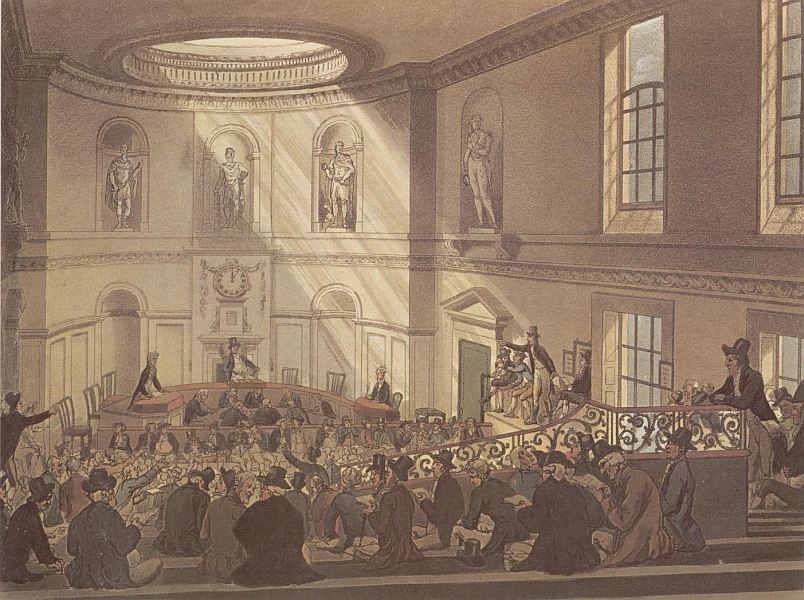British East India Company: Salaries Paid to 'Clerks', 1760-1820 (EIC)
 Thomas Rowlandson, The East India Company, from The Microcosm of London, 1808. ©London Lives.
Thomas Rowlandson, The East India Company, from The Microcosm of London, 1808. ©London Lives.
Introduction
The 11,736 individual records of annual payments to clerks employed by the East India Company included on this website were created as a part of a comprehensive longitudinal study of the careers and economic fortunes of the East India Company and its employees. Completed in 1999 and led by Dr H. M. Boot, the full dataset (including information for the period 1820 to 1850) and project description is available through the UK Data Archive:
The dataset posted on London Lives encompasses the first sixty years of the dataset, up to 31 December 1819, and is available for keyword and name searches only. If you wish to undertake a statistical analysis of this material you can access the full dataset in a range of formats through the http://www.data-archive.ac.uk. Copyright in this material remains with the original investigator, Hector Macdonald Boot, and the data is reproduced here by license, for non-commercial use only.
The period covered by this dataset includes that of the Company's greatest power. Following its establishment of a monopoly of trade with Bengal in 1757, and for the rest of the eighteenth century, the Company essentially governed India, acting as an independent state in all but name. Its power and authority were gradually transferred to the British government, though it continued to act as an independent company through the first half of the nineteenth century. In 1801, the company employed over 3,670 people as part of its home establishment, centred on East India House in Leadenhall Street, but also including a wide range of port and warehouse facilities.
The category of clerk, which forms the basis for this dataset, includes a high proportion of the Company's home employees, ranging from low servants to senior managers with executive authority. In the words of the Dr Boot:
And they should consult:
The Database
The original database incorporated eleven fields, including several elements rendered as numeric codes for ease of analysis. The sub-set of data posted here has been expanded to make the codes used in the original more accessible for the casual user and has been expanded to thirteen fields. Where these are blank in the original, they have been suppressed in the version displayed here. Where information is available for each possible field the record will include:
- Unique Project ID: Unique identification number.
- Surname
- Forename
- Employee ID: Eighteenth-century employer ID number.
- Notes: Frequently relating to the date and age of apprenticeship.
- Year: Year of this particular entry in the register of salaries.
- Years' Experience: Number of years the employee has served.
- Designated Office: A shortened, eighteenth-century description.
- Gratuity in £s: Amount earned in ex-gratia payments.
- Annual Salary in £s: Salary to the nearest whole pound.
- Total Income for the Year in £s: Salary plus gratuities.
- Department: Expanded and standardised description of the relevant East India Company department.
- Occupation: A standardised occupational label.
The contents of the Designated Office, Department, and Occupation fields were standardised and abbreviated in the original project, and these forms have been reproduced here. For a guide to the content of these fields see the UK Data Archive Project Guide. Years' of Experience can be used as a proxy for age, by adding 20 - the age at which most clerks started their employment.
A typical entry, looks like that for Charles Lamb, the writer and essayist, who joined the Company in 1792. Lamb first appears as an Established Clerk in this series in 1795. Blank fields have been suppressed in this display:
- Unique Project ID: 10491
- Surname: Lamb
- Forename: Charles
- Employee ID: 792
- Notes: App 1792/ age 20
- Year: 1795
- Years' Experience: 1
- Designated Office: Accts off
- Annual Salary in £s: 40
- Total Income for the Year in £s: 40
- Department: Accounts
- Occupation: 'Established' clerk
Back to Top | Introductory Reading
Using this Dataset in London Lives
The names of the men in these registers are unlikely to appear in the Old Bailey Proceedings (OBP) or Sessions Papers (PS) as defendants, or in parish records as paupers. Their presence in this series reflects a generally secure position among the middling sort. They are, however, likely to appear as parish officers, as victims and witnesses at the Old Bailey, and as jurors, both in the Old Bailey Proceedings (OBP) and at Coroners' Inquests (IC).
East India Company clerks are also likely appear in several of the additional datasets included in London Lives. In particular, there is a good likelihood of them appearing in the Westminster Historical Database (WHD); the London and Westminster Directory, 1774 (DIR); among testators listed in the Prerogative Court of Canterbury Wills (PCC); and in the Fire Insurance Policy Registers, 1777-1786 (FIR) and certificates of Income Tax Payments, 1799-1803 (ITP).
Original Sources
Introductory Reading
- Boot, H. M. Real Incomes of the British Middle Class, 1760 – 1850. Economic History Review, 52 (1999), pp. 638-68.
- Lawson, Philip. The East India Company: A History. 1993.
- Marshall, P. J. Bengal: The British Bridgehead, Eastern India, 1740-1828. The New Cambridge History of India, vol. 2. Cambridge, 1987.
Online Resources
- British East India Company: Salaries Paid to 'Clerks', 1760-1850
- Peter Marshall. The British Presence in India in the 18th Century.
For further reading on this subject see the London Lives Bibliography.